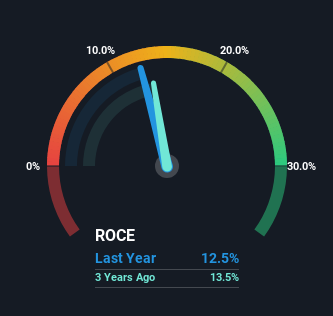- United States
- /
- Healthcare Services
- /
- NYSE:UHS
The Returns At Universal Health Services (NYSE:UHS) Aren't Growing

If you're not sure where to start when looking for the next multi-bagger, there are a few key trends you should keep an eye out for. Firstly, we'll want to see a proven return on capital employed (ROCE) that is increasing, and secondly, an expanding base of capital employed. Ultimately, this demonstrates that it's a business that is reinvesting profits at increasing rates of return. With that in mind, the ROCE of Universal Health Services (NYSE:UHS) looks decent, right now, so lets see what the trend of returns can tell us.
Understanding Return On Capital Employed (ROCE)
Just to clarify if you're unsure, ROCE is a metric for evaluating how much pre-tax income (in percentage terms) a company earns on the capital invested in its business. To calculate this metric for Universal Health Services, this is the formula:
Return on Capital Employed = Earnings Before Interest and Tax (EBIT) ÷ (Total Assets - Current Liabilities)
0.12 = US$1.5b ÷ (US$14b - US$2.0b) (Based on the trailing twelve months to September 2024).
Therefore, Universal Health Services has an ROCE of 12%. In absolute terms, that's a satisfactory return, but compared to the Healthcare industry average of 10% it's much better.
See our latest analysis for Universal Health Services

Above you can see how the current ROCE for Universal Health Services compares to its prior returns on capital, but there's only so much you can tell from the past. If you're interested, you can view the analysts predictions in our free analyst report for Universal Health Services .
What Can We Tell From Universal Health Services' ROCE Trend?
The trend of ROCE doesn't stand out much, but returns on a whole are decent. Over the past five years, ROCE has remained relatively flat at around 12% and the business has deployed 24% more capital into its operations. 12% is a pretty standard return, and it provides some comfort knowing that Universal Health Services has consistently earned this amount. Stable returns in this ballpark can be unexciting, but if they can be maintained over the long run, they often provide nice rewards to shareholders.
What We Can Learn From Universal Health Services' ROCE
To sum it up, Universal Health Services has simply been reinvesting capital steadily, at those decent rates of return. And given the stock has only risen 29% over the last five years, we'd suspect the market is beginning to recognize these trends. So to determine if Universal Health Services is a multi-bagger going forward, we'd suggest digging deeper into the company's other fundamentals.
On a final note, we've found 1 warning sign for Universal Health Services that we think you should be aware of.
While Universal Health Services may not currently earn the highest returns, we've compiled a list of companies that currently earn more than 25% return on equity. Check out this free list here.
New: AI Stock Screener & Alerts
Our new AI Stock Screener scans the market every day to uncover opportunities.
• Dividend Powerhouses (3%+ Yield)
• Undervalued Small Caps with Insider Buying
• High growth Tech and AI Companies
Or build your own from over 50 metrics.
Have feedback on this article? Concerned about the content? Get in touch with us directly. Alternatively, email editorial-team (at) simplywallst.com.
This article by Simply Wall St is general in nature. We provide commentary based on historical data and analyst forecasts only using an unbiased methodology and our articles are not intended to be financial advice. It does not constitute a recommendation to buy or sell any stock, and does not take account of your objectives, or your financial situation. We aim to bring you long-term focused analysis driven by fundamental data. Note that our analysis may not factor in the latest price-sensitive company announcements or qualitative material. Simply Wall St has no position in any stocks mentioned.
About NYSE:UHS
Universal Health Services
Through its subsidiaries, owns and operates acute care hospitals, and outpatient and behavioral health care facilities.
Very undervalued with proven track record.
Similar Companies
Market Insights
Community Narratives



